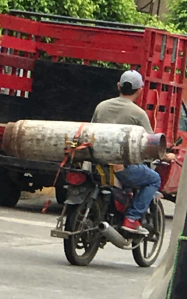Somewhere in the jungly mountains of Mexico lies the line between the states of Veracruz and Oaxaca. I suppose there is a sign on a highway somewhere that marks that state-line. But we did not travel on a major highway. We drove smaller roads through villages clinging to hillsides and fighting back the growth of trees and vines. Places where life is strenuous, muddy and traditional.
The scenes we see while passing through small villages and towns show glimpses of the lives being lived in these mountains. Here are a few photos with captions below each one.



Motorcycles are a major mode of transportation in all of Mexico. While animals are still used in smaller villages, they are gradually being replaced by cheap motorcycles. Mexico News Daily recently released an article on this topic. (click on this link to open article) In addition to carrying one to five passengers, they also carry cargo. Here are a couple of motorcycles being used as cargo haulers.


After long mountain drives (twisty, turning roads and steep grades are exhausting for the driver) we parked at a riverbank campsite near the town soccer field. It was a beautiful evening as the rain picked up and serenaded us. Through the night the rain increased in its intensity. By morning the river was raging loudly, just steps from our back door. You can hear the river roaring in the movie below.


We also went geocaching in this region. But of course, we found ourselves with no pen when we needed it. So we glued a googly-eye just above someones stamp and left a name card. You can order a sticker that says “It’s not a slow car, it’s a fast house” (looks just like this) from the home page of this website! 
The language continues to be a struggle for us. We can get by through most of the general conversations. But small talk, small details and ever-changing pronunciation is our stumbling block. One of the unique features of Spanish is that a “B” is generally pronounced “V” and a “V” is pronounced “B”. But that rule is not always true! This sign at a hamburger stand illustrates that even a native speaker struggles with these two letters! 
In a larger town we parked the rig and tried to grab a taxi to go to the museum. We climbed in the back of the taxi. Just as the driver was pulling away, a police officer approached and climbed in the front seat. They exchanged a few harsh words and the driver told us to get out of the cab. The policeman never looked at us or spoke to us. We climbed out and they drove away together! We stood on the sidewalk in shock at what just took place. A policeman stole our taxi. Then we walked a short distance and hailed another taxi. The next driver spoke enough English to explain to us what had happened. Apparently in this town there is competition for taxi service. The drivers have enlisted the help of the police to chase away the taxi’s from out of town. The first cab we stopped was from elsewhere and the officer saw that. He was escorting the man out of town! Once it was explained, we understood. But initially it felt as though the officer had stolen our cab!

This large town had a busy plaza in the center. And a small a small museum with an Olmec head on display. Another Olmec head is located in the center of the town plaza. In the video below you can see and hear the busy plaza, and the stone head. There are about 17 of these known to exist today.

Finally, as we are traveling through a jungle area of Mexico, we must endure some jungle bugs. I will leave you with a photo of the creature that passed over my toes while I was sipping my morning coffee. It could stretch itself from 5 inches to 9 inches long! Yuck.

I’m really enjoying your blog and vicariously seeing new parts of Mexico through your great photos. It’s one more inspiration to work towards an early retirement so we can move to Mexico earlier rather than later. My husband is Mexican and we already have a little house in Tepoztlán, Morelos. Every time I’m there I find it harder and harder to return to Toronto. After reading your blog, I’ve already told my husband I want to visit La Ermita del Silencio, only 2 hours from our house. Just a note on the pronunciation of “b” and “v”. The 2 letters are actually pronounced exactly the same in Spanish. The only way to distinguish is to ask how a word or name is spelled: “B” is “b grande” or “b de burro”. “V” is “v chica”, “v de vaca” or “uve”. “Uve” is now the official designation by the Real Academia Española, the official arbiter of Spanish language grammar, syntax, spelling, etc. (“Real” as in “Royal”, not as in real.) To pronounce the Spanish “b” or “v”, try making a “v” sound but without letting your lower teeth touch your lips. Make it with just your lips lightly touching (similar to English “b”) but then make the softer “v” sound. It really is a sound halfway between the English v and b. Good luck with your Spanish, and thank you for sharing your adventures with the rest of us!